Business Laws: Analysis of Insolvency and Corporate Veil Issues
VerifiedAdded on 2021/06/14
|9
|1712
|18
Report
AI Summary
This report analyzes a business law case involving Small Pty Ltd's insolvency. The report examines the options available to the administrator, concluding that winding up the company is the most suitable course of action due to its insolvency. It then investigates whether a secured creditor, Ravi, is entitled to make a claim, applying the principles of corporate veil and separate legal entity. The report concludes that Ravi is entitled to the secured loan. Finally, it determines the amount unsecured creditors may receive, considering the distribution of assets after the secured debt is paid. The analysis references relevant sections of the Corporations Act 2001 (Cth) and key legal precedents, including Salomon v A Salomon & Co Ltd and Macaura v Northern Assurance Co Ltd.

Running head: BUSINESS LAWS
Business Laws
Name of the student
Name of the university
Author note
Business Laws
Name of the student
Name of the university
Author note
Paraphrase This Document
Need a fresh take? Get an instant paraphrase of this document with our AI Paraphraser
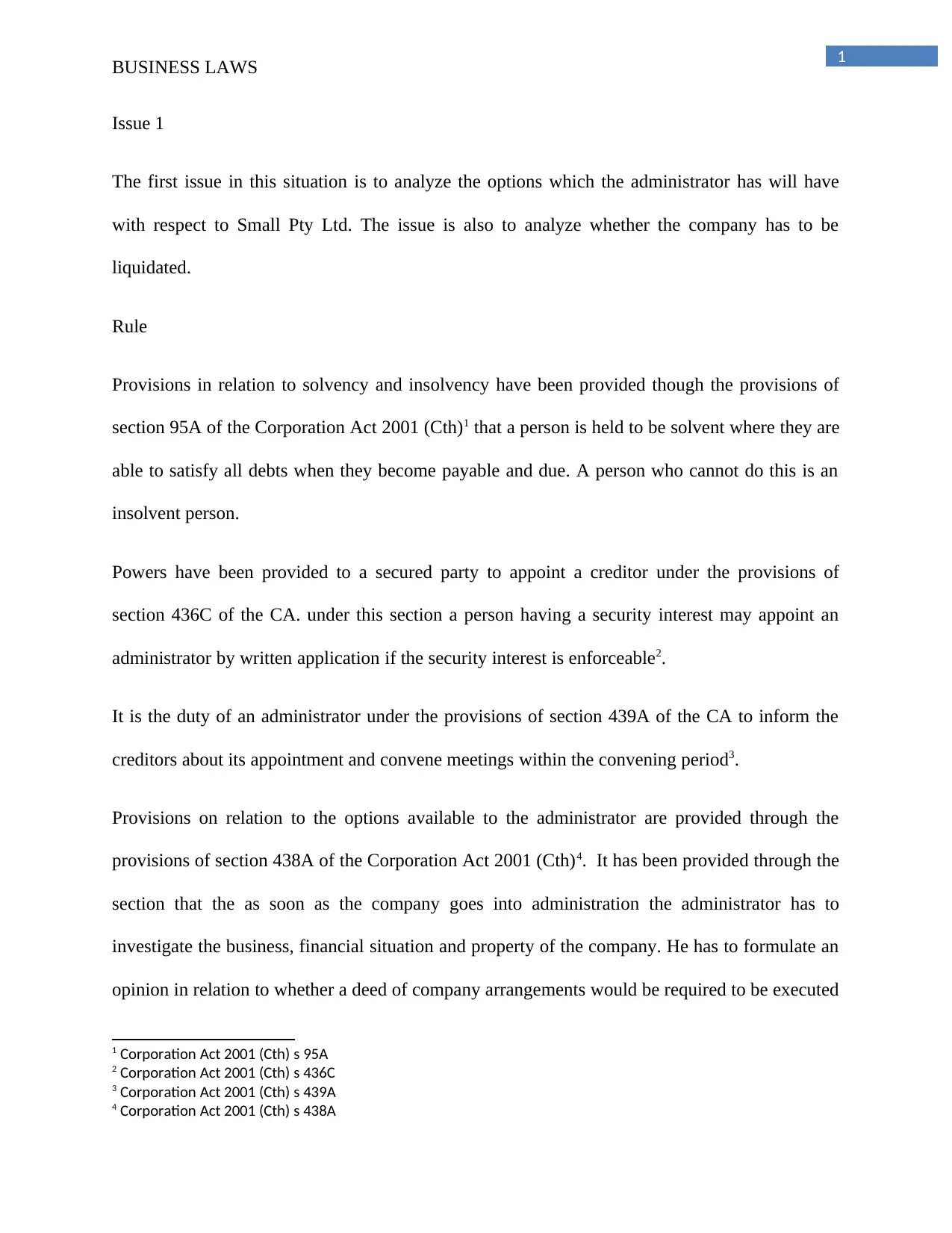
1
BUSINESS LAWS
Issue 1
The first issue in this situation is to analyze the options which the administrator has will have
with respect to Small Pty Ltd. The issue is also to analyze whether the company has to be
liquidated.
Rule
Provisions in relation to solvency and insolvency have been provided though the provisions of
section 95A of the Corporation Act 2001 (Cth)1 that a person is held to be solvent where they are
able to satisfy all debts when they become payable and due. A person who cannot do this is an
insolvent person.
Powers have been provided to a secured party to appoint a creditor under the provisions of
section 436C of the CA. under this section a person having a security interest may appoint an
administrator by written application if the security interest is enforceable2.
It is the duty of an administrator under the provisions of section 439A of the CA to inform the
creditors about its appointment and convene meetings within the convening period3.
Provisions on relation to the options available to the administrator are provided through the
provisions of section 438A of the Corporation Act 2001 (Cth)4. It has been provided through the
section that the as soon as the company goes into administration the administrator has to
investigate the business, financial situation and property of the company. He has to formulate an
opinion in relation to whether a deed of company arrangements would be required to be executed
1 Corporation Act 2001 (Cth) s 95A
2 Corporation Act 2001 (Cth) s 436C
3 Corporation Act 2001 (Cth) s 439A
4 Corporation Act 2001 (Cth) s 438A
BUSINESS LAWS
Issue 1
The first issue in this situation is to analyze the options which the administrator has will have
with respect to Small Pty Ltd. The issue is also to analyze whether the company has to be
liquidated.
Rule
Provisions in relation to solvency and insolvency have been provided though the provisions of
section 95A of the Corporation Act 2001 (Cth)1 that a person is held to be solvent where they are
able to satisfy all debts when they become payable and due. A person who cannot do this is an
insolvent person.
Powers have been provided to a secured party to appoint a creditor under the provisions of
section 436C of the CA. under this section a person having a security interest may appoint an
administrator by written application if the security interest is enforceable2.
It is the duty of an administrator under the provisions of section 439A of the CA to inform the
creditors about its appointment and convene meetings within the convening period3.
Provisions on relation to the options available to the administrator are provided through the
provisions of section 438A of the Corporation Act 2001 (Cth)4. It has been provided through the
section that the as soon as the company goes into administration the administrator has to
investigate the business, financial situation and property of the company. He has to formulate an
opinion in relation to whether a deed of company arrangements would be required to be executed
1 Corporation Act 2001 (Cth) s 95A
2 Corporation Act 2001 (Cth) s 436C
3 Corporation Act 2001 (Cth) s 439A
4 Corporation Act 2001 (Cth) s 438A
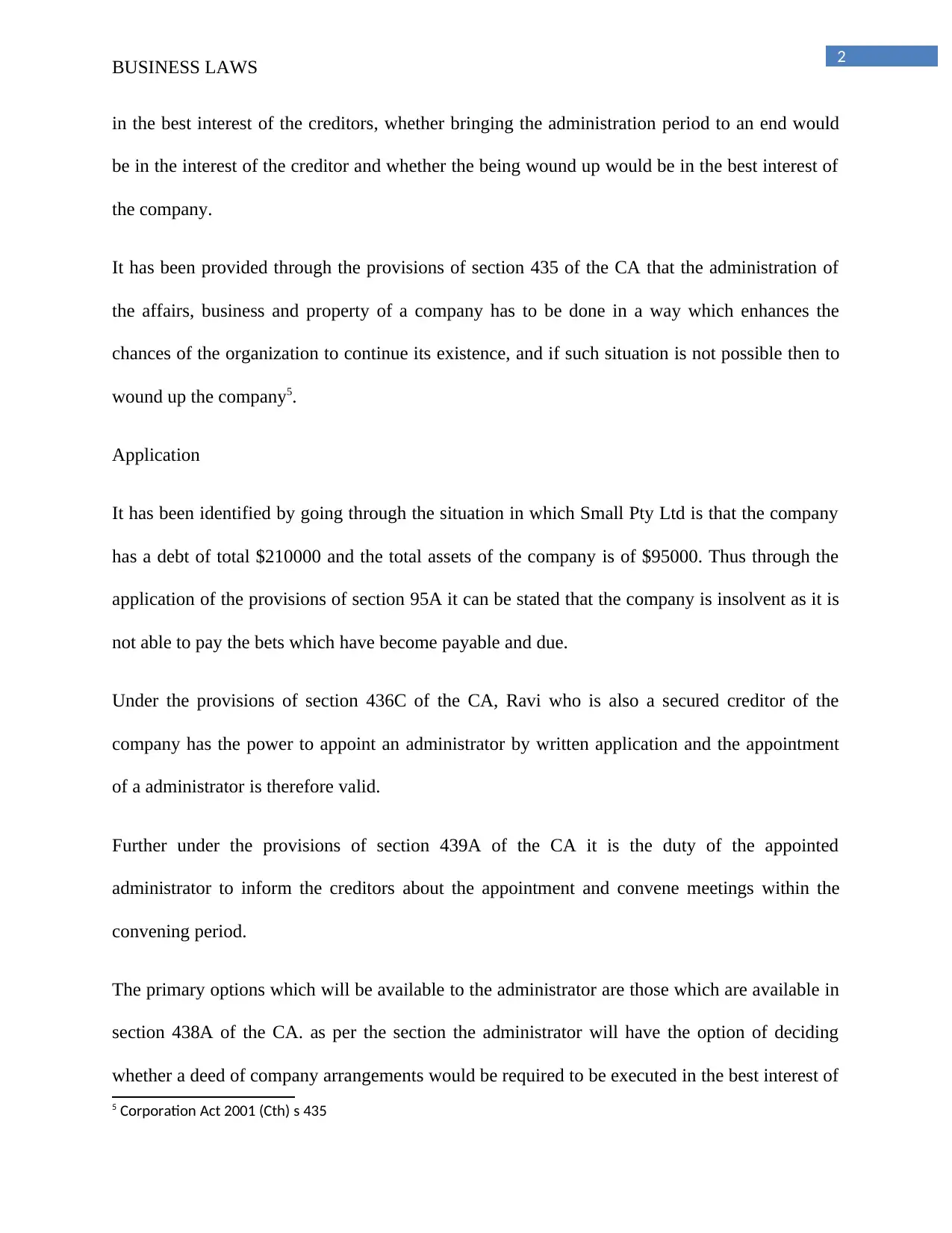
2
BUSINESS LAWS
in the best interest of the creditors, whether bringing the administration period to an end would
be in the interest of the creditor and whether the being wound up would be in the best interest of
the company.
It has been provided through the provisions of section 435 of the CA that the administration of
the affairs, business and property of a company has to be done in a way which enhances the
chances of the organization to continue its existence, and if such situation is not possible then to
wound up the company5.
Application
It has been identified by going through the situation in which Small Pty Ltd is that the company
has a debt of total $210000 and the total assets of the company is of $95000. Thus through the
application of the provisions of section 95A it can be stated that the company is insolvent as it is
not able to pay the bets which have become payable and due.
Under the provisions of section 436C of the CA, Ravi who is also a secured creditor of the
company has the power to appoint an administrator by written application and the appointment
of a administrator is therefore valid.
Further under the provisions of section 439A of the CA it is the duty of the appointed
administrator to inform the creditors about the appointment and convene meetings within the
convening period.
The primary options which will be available to the administrator are those which are available in
section 438A of the CA. as per the section the administrator will have the option of deciding
whether a deed of company arrangements would be required to be executed in the best interest of
5 Corporation Act 2001 (Cth) s 435
BUSINESS LAWS
in the best interest of the creditors, whether bringing the administration period to an end would
be in the interest of the creditor and whether the being wound up would be in the best interest of
the company.
It has been provided through the provisions of section 435 of the CA that the administration of
the affairs, business and property of a company has to be done in a way which enhances the
chances of the organization to continue its existence, and if such situation is not possible then to
wound up the company5.
Application
It has been identified by going through the situation in which Small Pty Ltd is that the company
has a debt of total $210000 and the total assets of the company is of $95000. Thus through the
application of the provisions of section 95A it can be stated that the company is insolvent as it is
not able to pay the bets which have become payable and due.
Under the provisions of section 436C of the CA, Ravi who is also a secured creditor of the
company has the power to appoint an administrator by written application and the appointment
of a administrator is therefore valid.
Further under the provisions of section 439A of the CA it is the duty of the appointed
administrator to inform the creditors about the appointment and convene meetings within the
convening period.
The primary options which will be available to the administrator are those which are available in
section 438A of the CA. as per the section the administrator will have the option of deciding
whether a deed of company arrangements would be required to be executed in the best interest of
5 Corporation Act 2001 (Cth) s 435
⊘ This is a preview!⊘
Do you want full access?
Subscribe today to unlock all pages.

Trusted by 1+ million students worldwide
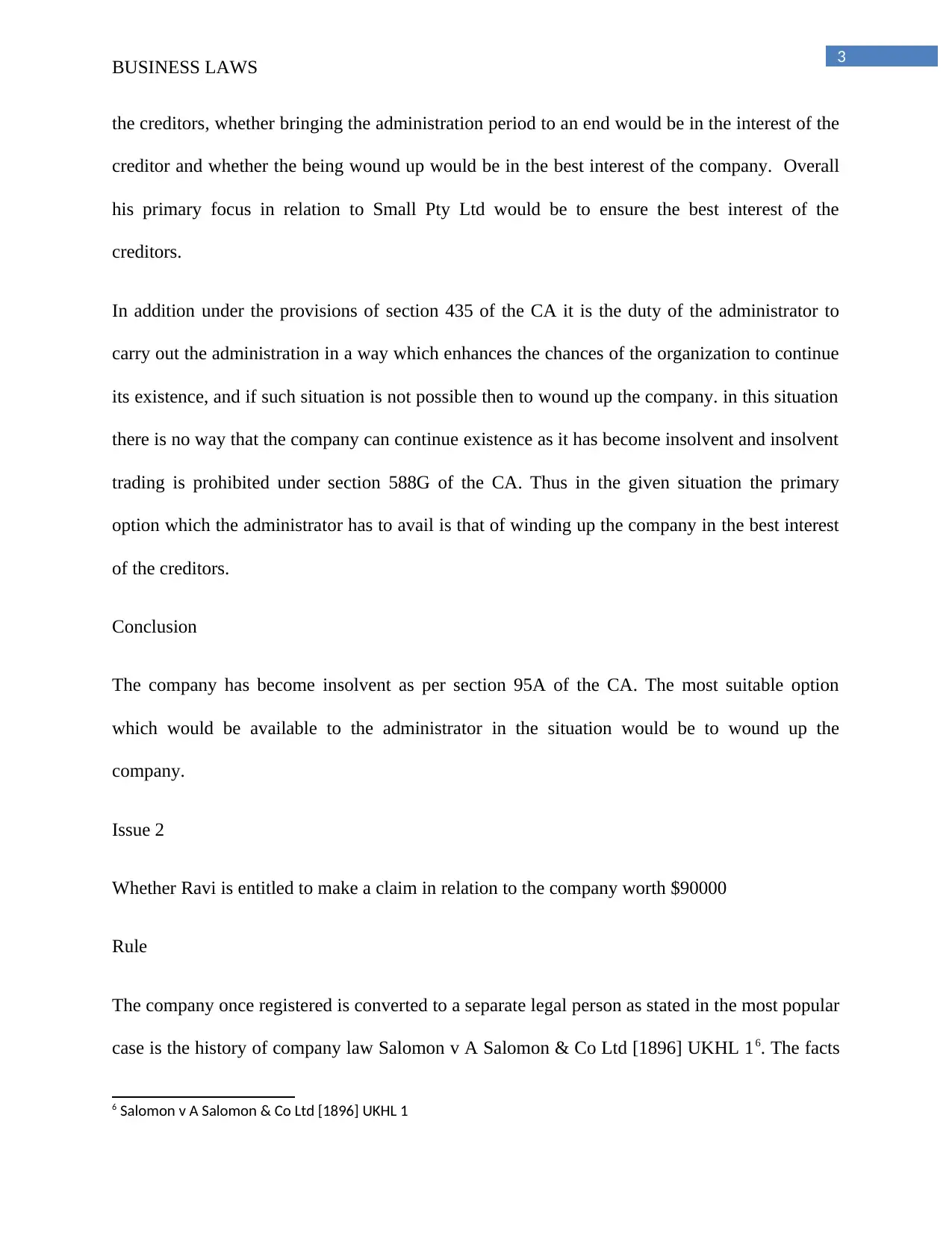
3
BUSINESS LAWS
the creditors, whether bringing the administration period to an end would be in the interest of the
creditor and whether the being wound up would be in the best interest of the company. Overall
his primary focus in relation to Small Pty Ltd would be to ensure the best interest of the
creditors.
In addition under the provisions of section 435 of the CA it is the duty of the administrator to
carry out the administration in a way which enhances the chances of the organization to continue
its existence, and if such situation is not possible then to wound up the company. in this situation
there is no way that the company can continue existence as it has become insolvent and insolvent
trading is prohibited under section 588G of the CA. Thus in the given situation the primary
option which the administrator has to avail is that of winding up the company in the best interest
of the creditors.
Conclusion
The company has become insolvent as per section 95A of the CA. The most suitable option
which would be available to the administrator in the situation would be to wound up the
company.
Issue 2
Whether Ravi is entitled to make a claim in relation to the company worth $90000
Rule
The company once registered is converted to a separate legal person as stated in the most popular
case is the history of company law Salomon v A Salomon & Co Ltd [1896] UKHL 16. The facts
6 Salomon v A Salomon & Co Ltd [1896] UKHL 1
BUSINESS LAWS
the creditors, whether bringing the administration period to an end would be in the interest of the
creditor and whether the being wound up would be in the best interest of the company. Overall
his primary focus in relation to Small Pty Ltd would be to ensure the best interest of the
creditors.
In addition under the provisions of section 435 of the CA it is the duty of the administrator to
carry out the administration in a way which enhances the chances of the organization to continue
its existence, and if such situation is not possible then to wound up the company. in this situation
there is no way that the company can continue existence as it has become insolvent and insolvent
trading is prohibited under section 588G of the CA. Thus in the given situation the primary
option which the administrator has to avail is that of winding up the company in the best interest
of the creditors.
Conclusion
The company has become insolvent as per section 95A of the CA. The most suitable option
which would be available to the administrator in the situation would be to wound up the
company.
Issue 2
Whether Ravi is entitled to make a claim in relation to the company worth $90000
Rule
The company once registered is converted to a separate legal person as stated in the most popular
case is the history of company law Salomon v A Salomon & Co Ltd [1896] UKHL 16. The facts
6 Salomon v A Salomon & Co Ltd [1896] UKHL 1
Paraphrase This Document
Need a fresh take? Get an instant paraphrase of this document with our AI Paraphraser
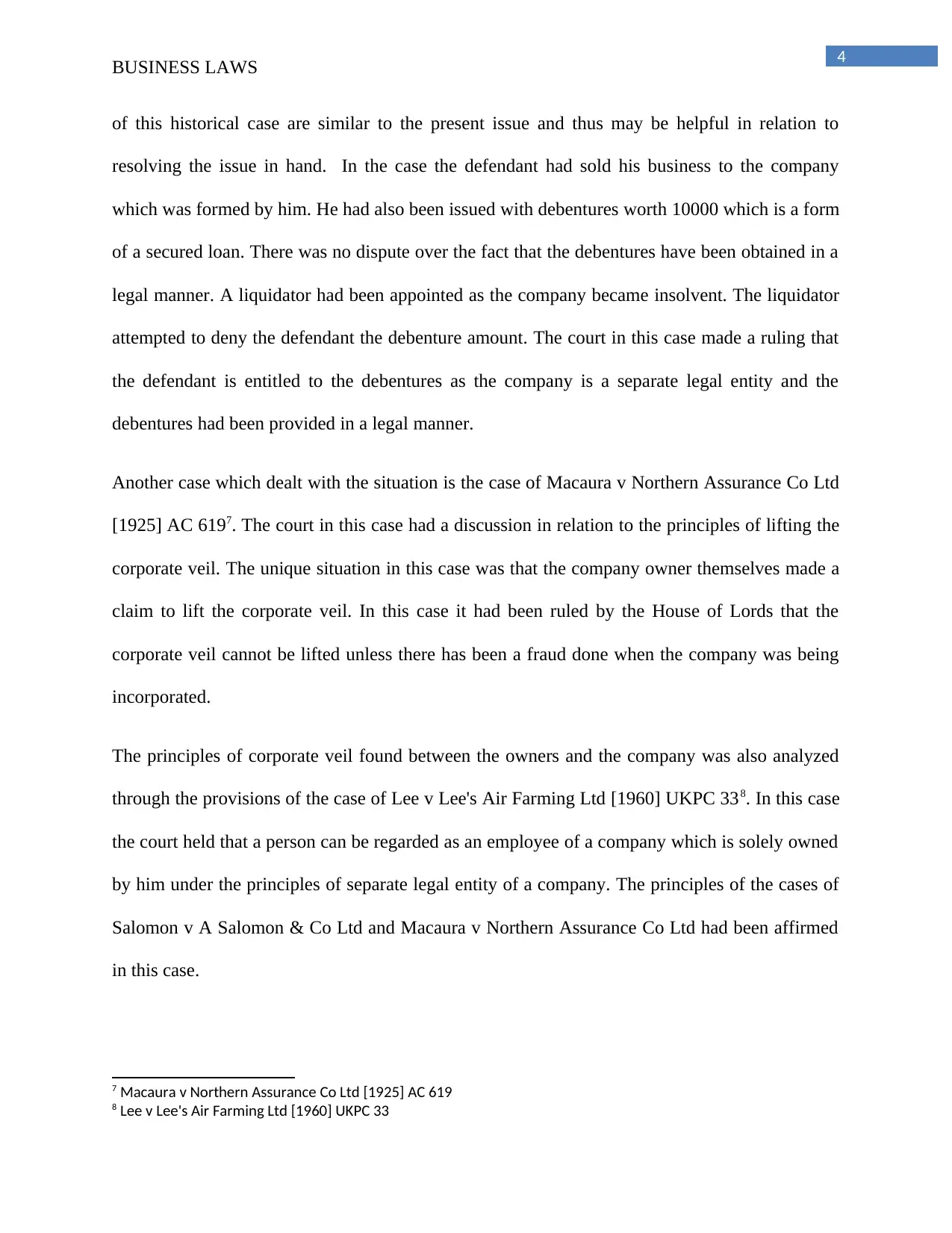
4
BUSINESS LAWS
of this historical case are similar to the present issue and thus may be helpful in relation to
resolving the issue in hand. In the case the defendant had sold his business to the company
which was formed by him. He had also been issued with debentures worth 10000 which is a form
of a secured loan. There was no dispute over the fact that the debentures have been obtained in a
legal manner. A liquidator had been appointed as the company became insolvent. The liquidator
attempted to deny the defendant the debenture amount. The court in this case made a ruling that
the defendant is entitled to the debentures as the company is a separate legal entity and the
debentures had been provided in a legal manner.
Another case which dealt with the situation is the case of Macaura v Northern Assurance Co Ltd
[1925] AC 6197. The court in this case had a discussion in relation to the principles of lifting the
corporate veil. The unique situation in this case was that the company owner themselves made a
claim to lift the corporate veil. In this case it had been ruled by the House of Lords that the
corporate veil cannot be lifted unless there has been a fraud done when the company was being
incorporated.
The principles of corporate veil found between the owners and the company was also analyzed
through the provisions of the case of Lee v Lee's Air Farming Ltd [1960] UKPC 338. In this case
the court held that a person can be regarded as an employee of a company which is solely owned
by him under the principles of separate legal entity of a company. The principles of the cases of
Salomon v A Salomon & Co Ltd and Macaura v Northern Assurance Co Ltd had been affirmed
in this case.
7 Macaura v Northern Assurance Co Ltd [1925] AC 619
8 Lee v Lee's Air Farming Ltd [1960] UKPC 33
BUSINESS LAWS
of this historical case are similar to the present issue and thus may be helpful in relation to
resolving the issue in hand. In the case the defendant had sold his business to the company
which was formed by him. He had also been issued with debentures worth 10000 which is a form
of a secured loan. There was no dispute over the fact that the debentures have been obtained in a
legal manner. A liquidator had been appointed as the company became insolvent. The liquidator
attempted to deny the defendant the debenture amount. The court in this case made a ruling that
the defendant is entitled to the debentures as the company is a separate legal entity and the
debentures had been provided in a legal manner.
Another case which dealt with the situation is the case of Macaura v Northern Assurance Co Ltd
[1925] AC 6197. The court in this case had a discussion in relation to the principles of lifting the
corporate veil. The unique situation in this case was that the company owner themselves made a
claim to lift the corporate veil. In this case it had been ruled by the House of Lords that the
corporate veil cannot be lifted unless there has been a fraud done when the company was being
incorporated.
The principles of corporate veil found between the owners and the company was also analyzed
through the provisions of the case of Lee v Lee's Air Farming Ltd [1960] UKPC 338. In this case
the court held that a person can be regarded as an employee of a company which is solely owned
by him under the principles of separate legal entity of a company. The principles of the cases of
Salomon v A Salomon & Co Ltd and Macaura v Northern Assurance Co Ltd had been affirmed
in this case.
7 Macaura v Northern Assurance Co Ltd [1925] AC 619
8 Lee v Lee's Air Farming Ltd [1960] UKPC 33
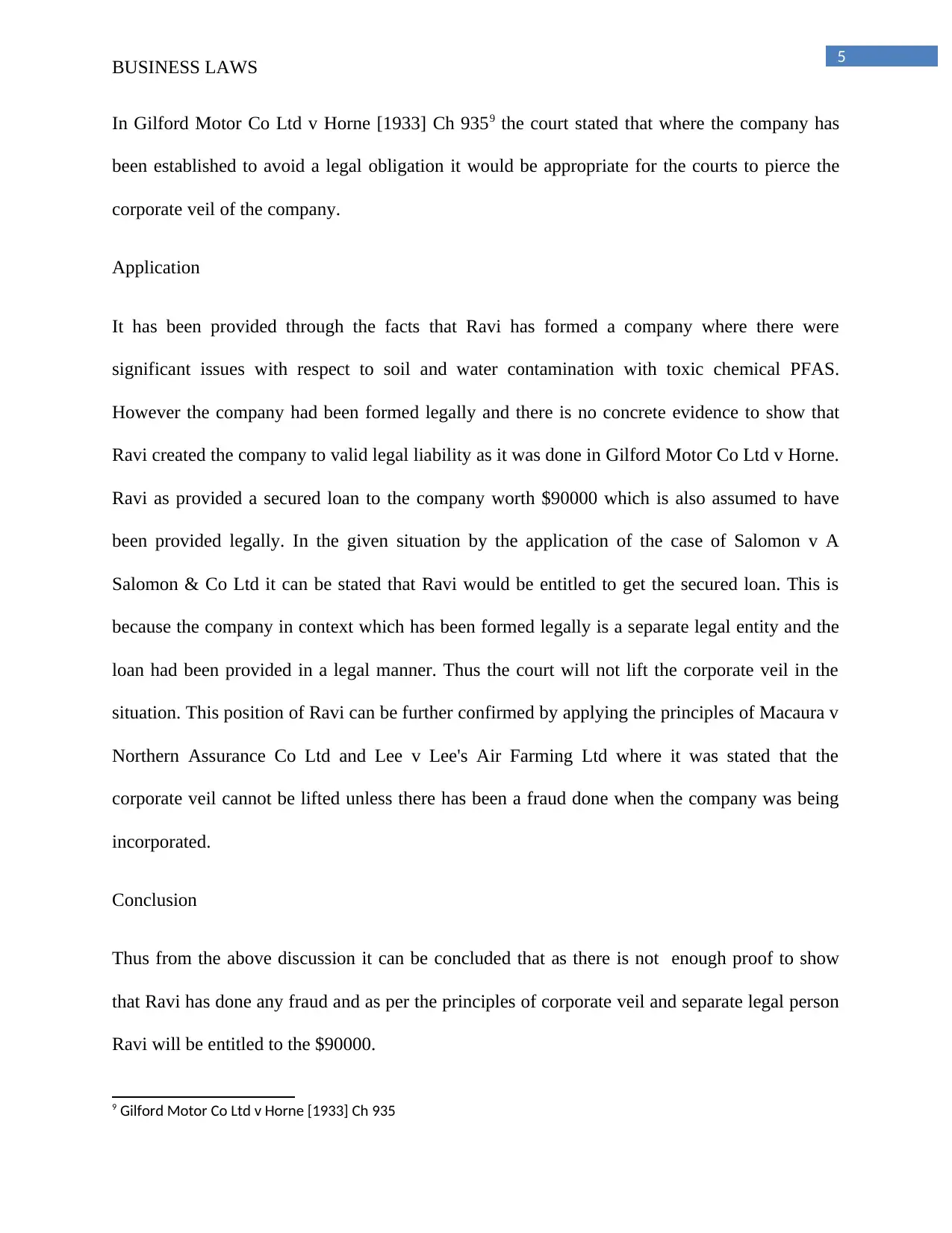
5
BUSINESS LAWS
In Gilford Motor Co Ltd v Horne [1933] Ch 9359 the court stated that where the company has
been established to avoid a legal obligation it would be appropriate for the courts to pierce the
corporate veil of the company.
Application
It has been provided through the facts that Ravi has formed a company where there were
significant issues with respect to soil and water contamination with toxic chemical PFAS.
However the company had been formed legally and there is no concrete evidence to show that
Ravi created the company to valid legal liability as it was done in Gilford Motor Co Ltd v Horne.
Ravi as provided a secured loan to the company worth $90000 which is also assumed to have
been provided legally. In the given situation by the application of the case of Salomon v A
Salomon & Co Ltd it can be stated that Ravi would be entitled to get the secured loan. This is
because the company in context which has been formed legally is a separate legal entity and the
loan had been provided in a legal manner. Thus the court will not lift the corporate veil in the
situation. This position of Ravi can be further confirmed by applying the principles of Macaura v
Northern Assurance Co Ltd and Lee v Lee's Air Farming Ltd where it was stated that the
corporate veil cannot be lifted unless there has been a fraud done when the company was being
incorporated.
Conclusion
Thus from the above discussion it can be concluded that as there is not enough proof to show
that Ravi has done any fraud and as per the principles of corporate veil and separate legal person
Ravi will be entitled to the $90000.
9 Gilford Motor Co Ltd v Horne [1933] Ch 935
BUSINESS LAWS
In Gilford Motor Co Ltd v Horne [1933] Ch 9359 the court stated that where the company has
been established to avoid a legal obligation it would be appropriate for the courts to pierce the
corporate veil of the company.
Application
It has been provided through the facts that Ravi has formed a company where there were
significant issues with respect to soil and water contamination with toxic chemical PFAS.
However the company had been formed legally and there is no concrete evidence to show that
Ravi created the company to valid legal liability as it was done in Gilford Motor Co Ltd v Horne.
Ravi as provided a secured loan to the company worth $90000 which is also assumed to have
been provided legally. In the given situation by the application of the case of Salomon v A
Salomon & Co Ltd it can be stated that Ravi would be entitled to get the secured loan. This is
because the company in context which has been formed legally is a separate legal entity and the
loan had been provided in a legal manner. Thus the court will not lift the corporate veil in the
situation. This position of Ravi can be further confirmed by applying the principles of Macaura v
Northern Assurance Co Ltd and Lee v Lee's Air Farming Ltd where it was stated that the
corporate veil cannot be lifted unless there has been a fraud done when the company was being
incorporated.
Conclusion
Thus from the above discussion it can be concluded that as there is not enough proof to show
that Ravi has done any fraud and as per the principles of corporate veil and separate legal person
Ravi will be entitled to the $90000.
9 Gilford Motor Co Ltd v Horne [1933] Ch 935
⊘ This is a preview!⊘
Do you want full access?
Subscribe today to unlock all pages.

Trusted by 1+ million students worldwide
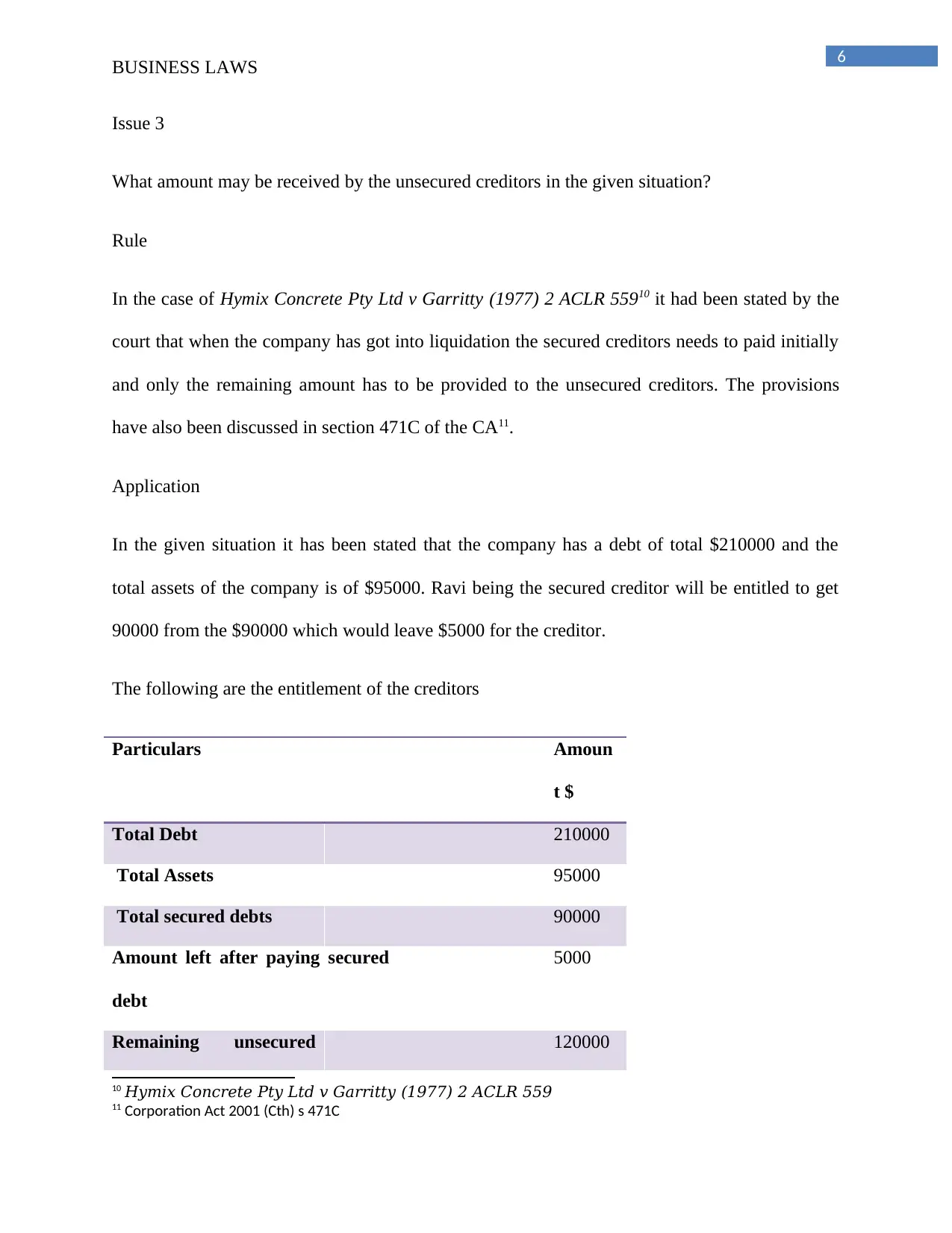
6
BUSINESS LAWS
Issue 3
What amount may be received by the unsecured creditors in the given situation?
Rule
In the case of Hymix Concrete Pty Ltd v Garritty (1977) 2 ACLR 55910 it had been stated by the
court that when the company has got into liquidation the secured creditors needs to paid initially
and only the remaining amount has to be provided to the unsecured creditors. The provisions
have also been discussed in section 471C of the CA11.
Application
In the given situation it has been stated that the company has a debt of total $210000 and the
total assets of the company is of $95000. Ravi being the secured creditor will be entitled to get
90000 from the $90000 which would leave $5000 for the creditor.
The following are the entitlement of the creditors
Particulars Amoun
t $
Total Debt 210000
Total Assets 95000
Total secured debts 90000
Amount left after paying secured
debt
5000
Remaining unsecured 120000
10 Hymix Concrete Pty Ltd v Garritty (1977) 2 ACLR 559
11 Corporation Act 2001 (Cth) s 471C
BUSINESS LAWS
Issue 3
What amount may be received by the unsecured creditors in the given situation?
Rule
In the case of Hymix Concrete Pty Ltd v Garritty (1977) 2 ACLR 55910 it had been stated by the
court that when the company has got into liquidation the secured creditors needs to paid initially
and only the remaining amount has to be provided to the unsecured creditors. The provisions
have also been discussed in section 471C of the CA11.
Application
In the given situation it has been stated that the company has a debt of total $210000 and the
total assets of the company is of $95000. Ravi being the secured creditor will be entitled to get
90000 from the $90000 which would leave $5000 for the creditor.
The following are the entitlement of the creditors
Particulars Amoun
t $
Total Debt 210000
Total Assets 95000
Total secured debts 90000
Amount left after paying secured
debt
5000
Remaining unsecured 120000
10 Hymix Concrete Pty Ltd v Garritty (1977) 2 ACLR 559
11 Corporation Act 2001 (Cth) s 471C
Paraphrase This Document
Need a fresh take? Get an instant paraphrase of this document with our AI Paraphraser

7
BUSINESS LAWS
debt
Amount to be received by unsecured
creditors per $
0.04
BUSINESS LAWS
debt
Amount to be received by unsecured
creditors per $
0.04
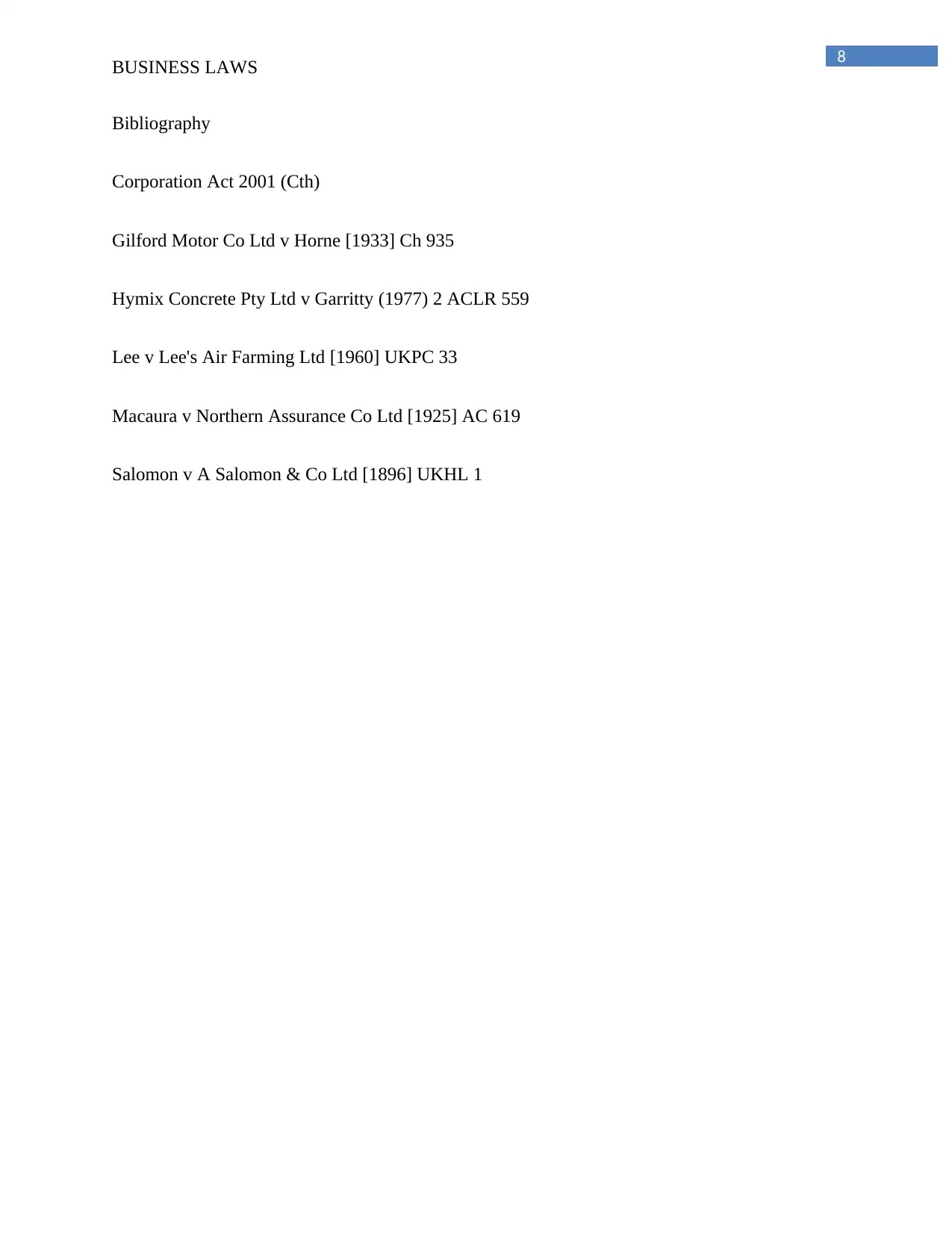
8
BUSINESS LAWS
Bibliography
Corporation Act 2001 (Cth)
Gilford Motor Co Ltd v Horne [1933] Ch 935
Hymix Concrete Pty Ltd v Garritty (1977) 2 ACLR 559
Lee v Lee's Air Farming Ltd [1960] UKPC 33
Macaura v Northern Assurance Co Ltd [1925] AC 619
Salomon v A Salomon & Co Ltd [1896] UKHL 1
BUSINESS LAWS
Bibliography
Corporation Act 2001 (Cth)
Gilford Motor Co Ltd v Horne [1933] Ch 935
Hymix Concrete Pty Ltd v Garritty (1977) 2 ACLR 559
Lee v Lee's Air Farming Ltd [1960] UKPC 33
Macaura v Northern Assurance Co Ltd [1925] AC 619
Salomon v A Salomon & Co Ltd [1896] UKHL 1
⊘ This is a preview!⊘
Do you want full access?
Subscribe today to unlock all pages.

Trusted by 1+ million students worldwide
1 out of 9
Related Documents
Your All-in-One AI-Powered Toolkit for Academic Success.
+13062052269
info@desklib.com
Available 24*7 on WhatsApp / Email
![[object Object]](/_next/static/media/star-bottom.7253800d.svg)
Unlock your academic potential
Copyright © 2020–2025 A2Z Services. All Rights Reserved. Developed and managed by ZUCOL.




